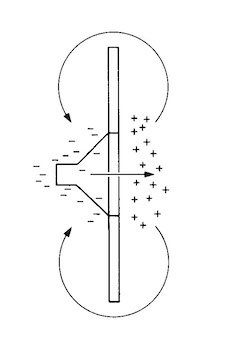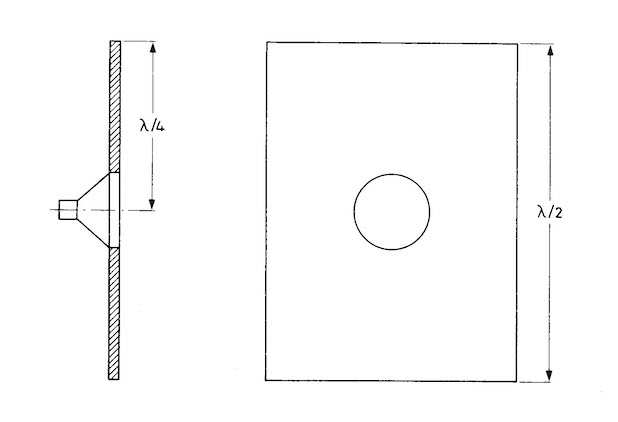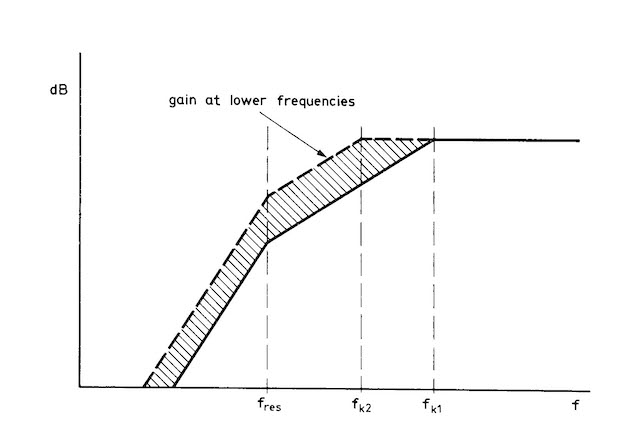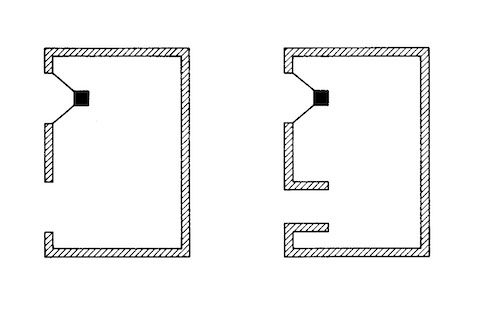There has been little development in speaker cabinet design for instrument applications since the beginning of amplified music. There are many cabinet types, of which two styles account for almost all commercial instrument cabinets: open-back and sealed enclosures. Unlike most other companies, most of our cabinet designs are of a vented or ported design.
There are a couple of acoustic basics that have a big impact on how we perceive sound. If you double the power to a speaker, the output increases by 3 dB. You can hear a change in volume this small, but it's not a big change. A 3 dB decrease is equivalent to halving the power. A 6 dB increase requires four times the power (2 x 2); a 6 dB decrease one-quarter the power (1/2 x 1/2). If you want to double the apparent volume, it requires ten times the power or a 10 dB increase. Similarly, a sound half as loud requires one-tenth the power.
An amplifier can run out of headroom very quickly if you turn it up quite high, have a wide dynamic range in the music, or boost frequencies with the tone controls / equalizer. A tone control providing 12 dB of boost requires almost 16 times the power when turned up all the way. In fact, most amps loaf along at fairly low power levels while in use. If you spend extra to buy a 125 W amp instead of a 100 W amp, you are buying yourself a whopping 0.97 dB of additional power in acoustic terms - essentially inaudible. You're better off acquiring a more efficient speaker system. Unfortunately, most amps do not meet their rated power specifications, especially tube amps. There are a number of design factors why this is the case. And power output is typically lower at the bottom and top end of the frequency response range.
Nor do we hear the sound at the same volume equally across the entire frequency range or at the same overall volume level. The ear is least sensitive to frequencies below about 250 Hz (particularly below 100 Hz), less sensitive than normal from about 8 to 12 kHz, and most sensitive in the 1 to 6 kHz range. The ear's response is quite variable at low volumes, while at high volumes the variations in perceived sound level are attenuated and the response flattens out.
A speaker by itself produces sound, but is subject to acoustic short-circuiting. This happens when sound from the front of the speaker passes around the sides of the speaker and arrives out of phase at the rear. This will cancel out the sound waves produced at the front, causing the sound output to roll off as the frequency falls. To avoid this, a speaker can be mounted on a baffle - a large, flat panel - which lengthens the sound path from front to back and lowers the frequency at which the sound begins to fall off.

Figure 1. Acoustic short-circuiting.
If you take the baffle and fold the edges back, you produce a box that is open at the back: commonly known as an open-back cabinet. The longer the path from front to back, the lower the cutoff frequency and the deeper and fuller the sound of the instrument from the speaker. A small open-back box sounds thin and weak, because the sound rolls off at a fairly high frequency and by the time it reaches the lower frequency ranges, it has been reduced quite a bit. A larger cabinet with a longer audio path from front to back produces a better low-end response. In short, the larger the open-back cabinet, the deeper and fuller the sound.

Figure 2. Speaker mounted on baffle (λ = wavelength at which rolloff begins).
An open-back cabinet will roll off the frequency response of the speaker at a rate of 6 dB/octave when it begins to acoustically short circuit. In addition, below the speaker's resonant frequency, more rolloff is added, producing a total rolloff of 18 dB/octave. That is equivalent to a fairly powerful highpass filter. The diameter of the speaker may be important, as larger speakers tend to have lower resonant frequencies.

Figure 3. Frequency response with baffle (Fk1 = unmounted, Fk2 = mounted on baffle).
If you close off the rear of the cabinet, you produce a sealed enclosure. The air inside the cabinet acts as a spring (compliance), becoming stiffer as the cabinet becomes smaller. The speaker's suspension also acts as a spring. Large-box speakers are generally known as infinite baffle designs (IB) and small-box as acoustic suspension designs (AS). An IB design has a stiffer spring in the speaker than for the box. An AS design is the opposite: the box is quite a bit stiffer than the speaker. An IB cabinet can be quite large, especially for instrument speakers, which are moderately stiff in the first place.

Figure 4. Sealed enclosure.
A speaker with a soft suspension can work well with a stiff enclosure, but instrument speakers tend to be fairly stiff in comparison to home audio speakers designed specifically for smaller cabinets. The efficiency of the system drops as the cabinet become stiffer. As the efficiency drops, more power is required to produce the same perceived sound level. The volume of sound the cabinet produces at lower frequencies is reduced, sometimes by quite a bit. Remember, your ear is not as sensitive at lower frequencies.
As with an open-back cabinet, a small sealed enclosure can have poor low frequency response. Many midrange speakers are made by installing a small woofer in a small, sealed enclosure, sharply reducing the low frequency response. As with open-back cabinets, a sealed cabinet is easy to make, and can handle higher power levels than the open-back designs. It can lack a full and deep sound, though, as the cabinet becomes less efficient at the size decreases, especially at lower frequencies. Again, the size of the speaker may be important, as larger speakers tend to have lower resonant frequencies.
A vented cabinet, on the other hand, uses sound radiated from the rear of the speaker to reinforce the sound from the front. This is done by creating a cabinet with its own resonant frequency to work with the installed speaker(s). The diameter of the speaker becomes less important, as the cabinet's resonant frequency contributes to the fuller and deeper sound of a well-tuned vented enclosure. Many home audio speakers use relatively small speakers for the low frequency sounds they are able to produce. The speakers this author uses with his main home audio system, for example, have a pair of eight-inch woofers in each cabinet, installed in a chamber tuned to provide smooth output down to 28 Hz.

Figure 5. Different types of vented enclosures (left: simple cutout port, right: ducted port).
This means that a wider range of speakers may be suitable with vented enclosures, not just restricted to the 12-inch speakers commonly used with electric guitars. Some guitar cabinets use 10- or 15-inch speakers, but these are generally not as common with guitars. For example, Torngat Audio has produced good-sounding cabinets using 8- and even 6-inch speakers (for portability).
We tune our vented cabinets to a frequency that will extend and reinforce the sound output to a lower frequency than conventional sealed or open-back cabinets, producing a rich and full sound from most of the speaker models that we have used. The low string on a 6-string guitar using conventional tuning vibrates at about 82 Hz (E3); the high string at about 330 Hz (E5), plus harmonics of the string vibrations at higher frequencies. Our vented cabinets provide reinforcement of the sound for 6- and 7-string guitars tuned as far down as low A or about 55 Hz (A2). Other tunings are equally-well handled. A guitar tuned to New Standard Tuning, for example, covers a range of about 65 Hz (C3) to 392 Hz (G5), plus harmonics.
Our cabinets are generally made larger than is the norm for the industry, making them more efficient and better sounding with instrument speakers. They are made out of Baltic birch, not regular plywoods or particle board, producing a very strong and relatively inert cabinet. All of these factors contribute to the fine sound obtained from our cabinets. Though the bottom end is much improved, the middle and high frequencies are much the same as with conventional open-back and sealed cabinets, as these frequencies are dominated by the speaker itself, with limited direct influence from the cabinet.
So, give our cabinets a listen and hear something different. Don't be bound to the idea that a 12-inch speaker is essential for guitar, because it is not – it's just one option. We welcome anyone to audition any speaker we have on hand to hear what they sound like. You might be pleasantly surprised and auditioning a cabinet costs nothing but your time.
Figures obtained from:
Building Hi-Fi Speaker Systems
Hull, M.D.
Copyright N.V. Philips' Gloeilampenfabriken, Eindhoven, The Netherlands
Sixth edition February 1977
Studio 112: 1x12" Celestion V-Type, black Tolex (Nubtex finish), with steel-mesh grill.
Return to index